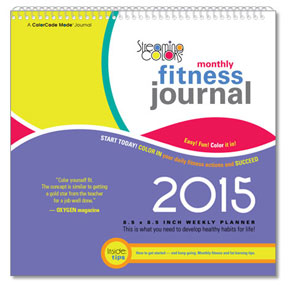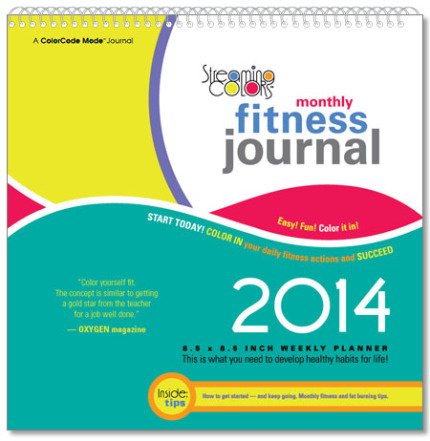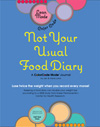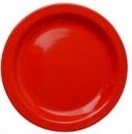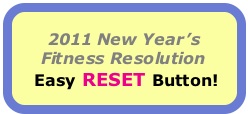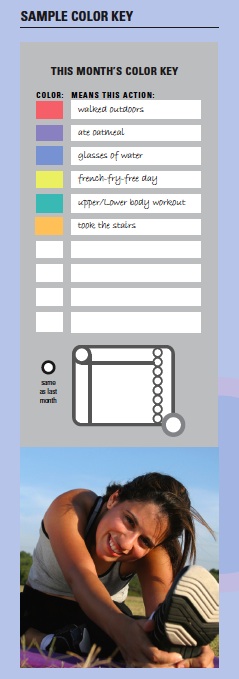Jen, the mom at Luhrs Media writes:
 forcechange.com I was so disappointed that the LA public school district (LAUSD) school board decided not to let Jamie Oliver film in their cafeterias. They didn't want the drama of a reality show. Better to let the kids have the drama of showing up in the emergency room somewhere down the road due to an obesity-related illness, I guess. Ah well.
forcechange.com I was so disappointed that the LA public school district (LAUSD) school board decided not to let Jamie Oliver film in their cafeterias. They didn't want the drama of a reality show. Better to let the kids have the drama of showing up in the emergency room somewhere down the road due to an obesity-related illness, I guess. Ah well.
You can learn more about it in this TODAY show video.
As you saw in one of my previous long blog posts (Jamie Oliver gives me so much to talk/rant about!), I'm a big fan of what he did in Huntington, West Virginia, even if there was a little back-sliding. Two steps forward, one step back. It's still progress.
Looks like the LA story's not over yet, though.
Just saw this from The Guardian in the UK. In an Observer interview with Ian Tucker, Jamie laments the lack of transparency he thought should exist in a government-run program (I suppose it would help if he were a U.S. citizen.) But he appears to have managed to sneak into an LA school kitchen anyway.
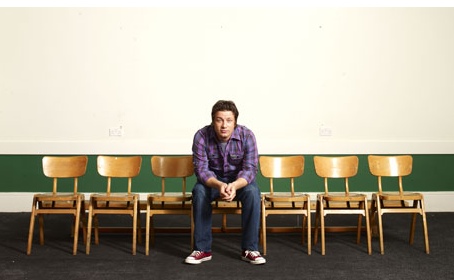 guardian.co.uk The Observer, Photograph by Phil Fisk/C4"I don't have any access but you know me – I'm kinda like a bad rash. I tend not to go away. It's been very tough but we got into one school via a loophole and we've been working with a lot of families in their homes. I've seen some of the most compelling, upsetting and inspiring stuff that I have ever done. If one of the threads of the story is a lack of transparency, then so be it, but I didn't start it. That would never happen back home."
guardian.co.uk The Observer, Photograph by Phil Fisk/C4"I don't have any access but you know me – I'm kinda like a bad rash. I tend not to go away. It's been very tough but we got into one school via a loophole and we've been working with a lot of families in their homes. I've seen some of the most compelling, upsetting and inspiring stuff that I have ever done. If one of the threads of the story is a lack of transparency, then so be it, but I didn't start it. That would never happen back home."
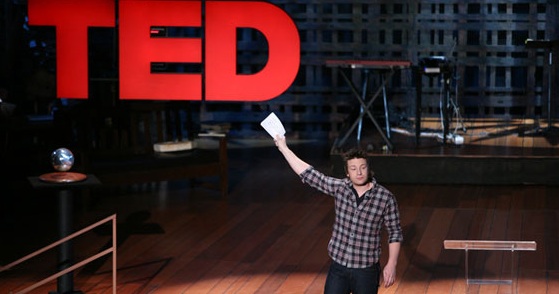 The rest of Tucker's interview is good reading, too. Jamie Oliver was a less than stellar student, who's a role model (with a TED prize!) for other less than stellar students, once you light a fire under them, which he's trying to do with the school he's set up.
The rest of Tucker's interview is good reading, too. Jamie Oliver was a less than stellar student, who's a role model (with a TED prize!) for other less than stellar students, once you light a fire under them, which he's trying to do with the school he's set up.
 jamieoliver.comMaybe it takes a non-academic to cut through all the double-speak of marketers, government agencies and endless research studies, to matter-of-factly dump the fatty deep-fried over-processed food on the kitchen table and say quite simply to the parent, "This is the food that is killing your family."
jamieoliver.comMaybe it takes a non-academic to cut through all the double-speak of marketers, government agencies and endless research studies, to matter-of-factly dump the fatty deep-fried over-processed food on the kitchen table and say quite simply to the parent, "This is the food that is killing your family."
Oliver set up a special dream school for kids who couldn't cut it in traditional academics. I had been thinking that in the U.S., a charter school focused on healthy eating and nutrition might be one way to overcome the defensiveness and insistence of some parents that their kids be allowed to eat junky foods at school. Ooh, what a can of worms you open up when you challenge just about any parent on how they feed their kids.
At least with a charter school, the parents who want something better for their kids could opt in. Such a school would have been a dream come true for me when Alexis was in school, although I did find a certain purposefulness and pleasure in making her lunches.
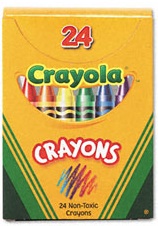 I'm not a morning person (unless it's the wee hours of the morning when I'm up writing) but I used to pop up like toast to make her healthy lunches. I didn't want her to feel weird for having a bag lunch, and just writing her name on the paper lunch bags seemed kind of boring so I also decorated them with crayon drawings. At seven in the morning. Me. One of her little girlfriends took some home and put them on her wall. First time my artwork has been hung by anyone, as far as I know.
I'm not a morning person (unless it's the wee hours of the morning when I'm up writing) but I used to pop up like toast to make her healthy lunches. I didn't want her to feel weird for having a bag lunch, and just writing her name on the paper lunch bags seemed kind of boring so I also decorated them with crayon drawings. At seven in the morning. Me. One of her little girlfriends took some home and put them on her wall. First time my artwork has been hung by anyone, as far as I know.
It looks as though there's a charter school in Chicago that's putting the emphasis on health and fitness, and it's involving the parents, which is key. By and large, these kids have learned their attitudes about food and their eating habits from their parents.
You know, the thing about parents and excess weight is that we figure we can always lose it, and so can our kids, and no harm's been done, right?
What if some of the effects of poor eating in early childhood were irreversible?
 What if all the parents and grandparents who spend a fortune on infant learning toys and pre-preschools to boost their offsprings' IQ's were made aware that "a predominantly processed-food diet at the age of three is directly associated with a lower IQ at the age of eight and a half, according to a Bristol-based study of thousands of British children."
What if all the parents and grandparents who spend a fortune on infant learning toys and pre-preschools to boost their offsprings' IQ's were made aware that "a predominantly processed-food diet at the age of three is directly associated with a lower IQ at the age of eight and a half, according to a Bristol-based study of thousands of British children."
Would it be enough to change how some of them feed their kids and grandkids?
Not that all parents are fanatical about IQ or school performance, but I've never ever heard of a parent who said they wished their kids could be dumber or would have to struggle harder in school.
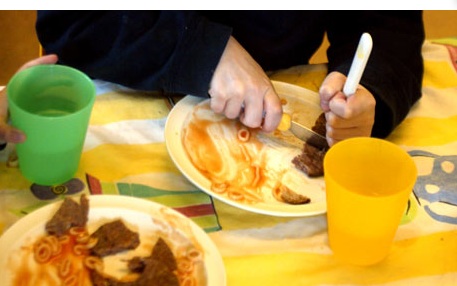 Nursery child eating lunch. Photo: Graham TurnerA study like this might not start a rush to free-range organic chicken, but it might at least get parents to question the wisdom of feeding a toddler deep-fried, chemical and fat-laden chicken nuggets five or six times a week. To perhaps throw in some vegetables, fruit and milk and other brain food.
Nursery child eating lunch. Photo: Graham TurnerA study like this might not start a rush to free-range organic chicken, but it might at least get parents to question the wisdom of feeding a toddler deep-fried, chemical and fat-laden chicken nuggets five or six times a week. To perhaps throw in some vegetables, fruit and milk and other brain food.
(Side note: Um, I don't think the hands holding the knife in that photo belong to a "nursery child." As someone who has styled photos, I notice stuff like that.Compare the size of those hands to the child's hand holding the green glass. Maybe they had some liability issues with having the child hold a knife. Especially since so many kids today don't know what a knife is for.)
What would happen if we changed the emphasis from "you might have a fat kid" to "feed your kid's brain properly during the first three years of life when its growth rate is fastest or their IQ will be lower in grade school and improving their diet at that point won't increase it."
I can see why Jamie Oliver's "hair's on fire" over childhood nutrition.
It's been breaking my heart for decades, too, to see what's being fed to such lovely little children with so much potential. The food in the pre-schools and daycare centers isn't substantially any better than the food in the grade schools and high schools where Jamie's been focusing.
 jamieoliver.comTo be honest, we've had this information in one form or another for decades, or I wouldn't have been so diligent to introduce my daughter right off the bat to a highly-nutritious diet of home-cooked food even though I was a working mom.
jamieoliver.comTo be honest, we've had this information in one form or another for decades, or I wouldn't have been so diligent to introduce my daughter right off the bat to a highly-nutritious diet of home-cooked food even though I was a working mom.
Cooking up simple foods is not that hard. It's actually pretty easy. As far as I'm concerned, there's no excuse for not doing it. It's no different than making sure your child gets a bath and has clean clothes.
Why has nutrition gone all to hell these past three or four decades?
The ubiquitous fast food, junk food, over-processed convenience food and high calorie/empty calorie food being marketed to us non-stop would be a good place to start.
 www.nutrition.govBut that's free enterprise, and if we listen to the more rabid "personal responsibility" people the onus is on the consumer, even the two-year-old consumer apparently, to have the willpower to just say no if their parents are too uninformed to know that soda pop and a Happy Meal is a crappy meal for a child's developing brain.
www.nutrition.govBut that's free enterprise, and if we listen to the more rabid "personal responsibility" people the onus is on the consumer, even the two-year-old consumer apparently, to have the willpower to just say no if their parents are too uninformed to know that soda pop and a Happy Meal is a crappy meal for a child's developing brain.
See how ridiculous that reasoning is?
Especially since many young parents today have been raised on the same crappy food (probably losing a few IQ points in the process) and don't even know how crappy it is. Or where to begin to develop healthy eating habits.
So who is protecting the innocent three-and-under crowd to make sure their fast-developing brains get proper nutrition?
 Well, that would be the United States Department of Agriculture, a lumbering giant of an agency charged with the conflicting goal of guarding America's nutritional health while keeping food producers happy. Not sure how much you paid your lobbyist lately but I'll bet it's not nearly enough to compete with the big food interests.
Well, that would be the United States Department of Agriculture, a lumbering giant of an agency charged with the conflicting goal of guarding America's nutritional health while keeping food producers happy. Not sure how much you paid your lobbyist lately but I'll bet it's not nearly enough to compete with the big food interests.
Mark Bittman does a good job of summing it up in his online commentary for the New York Times called "Is 'Eat Real Food' Unthinkable?"
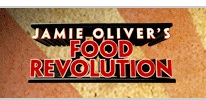 You say you want a revolution well I say, it's going to be tough because the culprits are so spread out. At least Egyptians could focus on one man, Mubarek.
You say you want a revolution well I say, it's going to be tough because the culprits are so spread out. At least Egyptians could focus on one man, Mubarek.
The unhealthy food problem runs so deep in America, even schools who think they're doing a good job are still feeding the kids junk. You'll have to read down into Natalie's comment (#3) in this ForceChange petition to see what I think sums up perfectly what I was feeling as a parent over twenty years ago.
Here's the test of how good your child's food is.
Sit down and eat what they're feeding your child for lunch some time. If it seems like substandard, unhealthy food to you, that you wouldn't want to eat, do you really want them shoveling it into your precious little one day after day and training his or her taste buds to accept and even crave such crummy food?
My advice to Natalie would be to pack him a real food lunch. If a child's taste-buds are trained to enjoy real food, those over-processed foods taste like the junk that they are and he'll grow up resisting them.
To 'Eat Real Food' should be affordable, right?
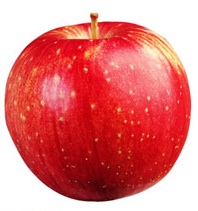 For a lot of people these days, the mantra 'Eat Real Food' is simply unaffordable when it comes to getting enough servings of fresh fruits and vegetables for a whole family. Have you seen the price of apples, that not-exotic, hard-working, keep-the-doctor-away staple for me when I was growing up?
For a lot of people these days, the mantra 'Eat Real Food' is simply unaffordable when it comes to getting enough servings of fresh fruits and vegetables for a whole family. Have you seen the price of apples, that not-exotic, hard-working, keep-the-doctor-away staple for me when I was growing up?
My mom was the worst at keeping the frig stocked with much of anything, but woe to her if there was not a steady supply of apples so I could eat one as I walked to elementary school each day. With many apples now costing as much as or more than a McDouble cheeseburger, I can see why a lot of struggling families are choosing the latter so their kids at least get some protein for the day.
The new USDA Dietary Guidelines are easy to understand and not unreasonable.
They're just completely unaffordable for an awful lot of American families, recession or no recession.
 usda.govHere's the food the report splashes across the top of the page. Yum. Doesn't that look good? It's mouthwatering, and aspirational, and a pipe dream for a lot of families who are lucky to scrape together a dollar or two to buy a box of generic mac and cheese and hope there's some unsoured milk left at the bottom of the milk container to make it with so no one goes to bed totally hungry.
usda.govHere's the food the report splashes across the top of the page. Yum. Doesn't that look good? It's mouthwatering, and aspirational, and a pipe dream for a lot of families who are lucky to scrape together a dollar or two to buy a box of generic mac and cheese and hope there's some unsoured milk left at the bottom of the milk container to make it with so no one goes to bed totally hungry.
Hello. The people who can afford a steady diet of the food pictured above are the ones who made out like bandits with the Bush tax cuts.
There is a HUGE disconnect between what Washington tells us to eat and the policies they have in place that affect the prices and food supply to which we have access.
The show I'd like to see is Jamie Oliver going into the offices of the USDA and asking them why we don't have a program to increase the abundance of and somehow support an eminently affordable price for the five servings a day of fruits and vegetables we're all supposed to be eating, while removing the subsidies that support unhealthy high-fructose corn syrup products.
Give the farmers a decent price and then get the fresh fruits and veggies to the consumer for cheap, cheap, cheap, including convenience stores in low-income areas with few grocery stores. An apple for 25 cents or a bag of salty, greasy chips for $1.25? At that price, the apple just might have a chance.
(And where would we get the money for that? From a nominal tax on soda pop and other junky fast foods? What? A tax on huge corporations that make zillions of dollars off of destroying America's health? How unfair! Get over it, bleeding heart conservatives. The corporations and Wall Street will adjust and be just fine. They have every advantage. Unlike the two-year-olds who don't have two nickels to rub together.)
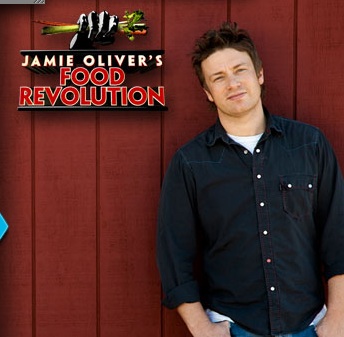 jamieoliver.comThere you go, Jamie. Try to get some transparency and straight, sensible answers out of the USDA. Just for starters. Dump the crappy food out on their desks and say, "This is the food that is killing the people of America."
jamieoliver.comThere you go, Jamie. Try to get some transparency and straight, sensible answers out of the USDA. Just for starters. Dump the crappy food out on their desks and say, "This is the food that is killing the people of America."
Then you could get back to the lunch ladies.
 Also, if you're in Southern California where Jamie is shooting and would like to become part of the grassroots movement, sign up on the LA page where there's also a Facebook link.
Also, if you're in Southern California where Jamie is shooting and would like to become part of the grassroots movement, sign up on the LA page where there's also a Facebook link.
If you've read all this, hey thanks for reading along. I know it's a lot, but this is the stuff that keeps me up at night and it helps to get it all out into the ColorCodeMode.com blog.
2014 Hollywood Half Marathon & 5K/10K Finishers Medal

 Tuesday, March 31, 2015 at 12:01AM
Tuesday, March 31, 2015 at 12:01AM  [Alexis]
[Alexis] 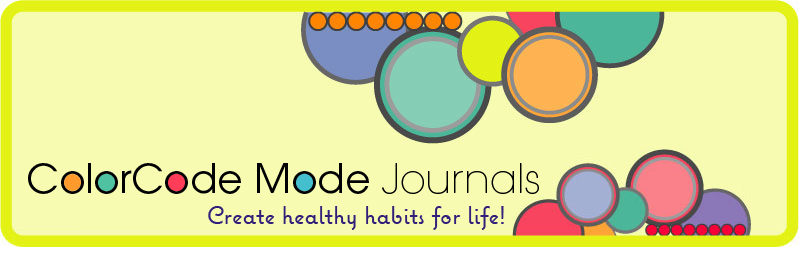


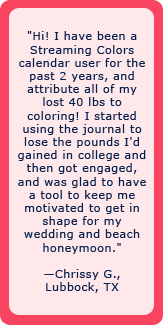
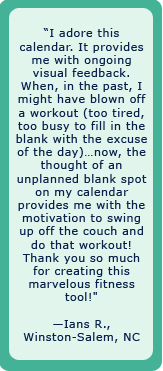

 digg
digg technorati
technorati reddit
reddit StumbleUpon
StumbleUpon
